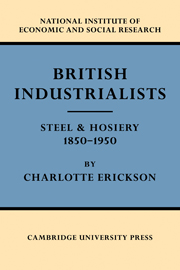Book contents
- Frontmatter
- Contents
- LIST OF TABLES
- Foreword
- Introduction
- I SCOPE OF THE INQUIRY
- II SOCIAL ORIGINS OF THE STEEL MANUFACTURERS
- III CAREERS OF THE STEEL MANUFACTURERS
- IV SOCIAL ORIGINS OF THE NOTTINGHAM HOSIERS
- V CAREERS OF THE HOSIERY MANUFACTURERS
- VI THE INTRODUCTION OF NEW TECHNIQUES IN STEEL-MAKING
- VII HOSIERY INNOVATORS
- VIII THE PUBLIC COMPANY
- Appendix A Selection of firms
- Appendix B List of firms included in steel study
- Appendix C Selection of men for steel study
- Appendix D The hosiery samples
- Appendix E Classification of fathers' occupations
- Appendix F Notes on comparisons with Population Census
- Appendix G Education
- Appendix H Marriages
- Appendix I Careers
- Appendix J Public company tables
- List of Principal Works Cited
- Index of names
- Index of companies
- General index
- PUBLICATIONS OF THE NATIONAL INSTITUTE OF ECONOMIC AND SOCIAL RESEARCH
V - CAREERS OF THE HOSIERY MANUFACTURERS
Published online by Cambridge University Press: 07 October 2011
- Frontmatter
- Contents
- LIST OF TABLES
- Foreword
- Introduction
- I SCOPE OF THE INQUIRY
- II SOCIAL ORIGINS OF THE STEEL MANUFACTURERS
- III CAREERS OF THE STEEL MANUFACTURERS
- IV SOCIAL ORIGINS OF THE NOTTINGHAM HOSIERS
- V CAREERS OF THE HOSIERY MANUFACTURERS
- VI THE INTRODUCTION OF NEW TECHNIQUES IN STEEL-MAKING
- VII HOSIERY INNOVATORS
- VIII THE PUBLIC COMPANY
- Appendix A Selection of firms
- Appendix B List of firms included in steel study
- Appendix C Selection of men for steel study
- Appendix D The hosiery samples
- Appendix E Classification of fathers' occupations
- Appendix F Notes on comparisons with Population Census
- Appendix G Education
- Appendix H Marriages
- Appendix I Careers
- Appendix J Public company tables
- List of Principal Works Cited
- Index of names
- Index of companies
- General index
- PUBLICATIONS OF THE NATIONAL INSTITUTE OF ECONOMIC AND SOCIAL RESEARCH
Summary
Not only did Nottingham's hosiery manufacturers come from a different social background than the leaders of the nation's steel industry, but they also brought remarkably different kinds of training and experience to the firms they led. From nearly every point of view, the average hosier's career contrasted with that of the average steel manufacturer. If one looks at the careers of Nottingham hosiers first of all from the standpoint of principal types of experience, the contrast with steel is substantial. Hosiers who started a business of their own have remained numerous in hosiery whereas independents have practically disappeared from the steel industry. On the other hand, though there have always been more hosiers who were sons of hosiers than steel manufacturers who were sons of steel manufacturers, the proportion of twentieth-century leaders who either followed family careers or invested in going concerns has been higher in steel than it was in hosiery. The salaried-administrator type is less highly developed in hosiery and the professional career man practically non-existent.
Of primary importance is the fact that independents, men who either founded their own firms or bought out and took over existing firms, did not decline during the first third of the twentieth century as they did in the steel industry (see Table 49). In every period studied, except the most recent, more than two in five hosiery manufacturers had independent careers in this sense.
- Type
- Chapter
- Information
- British IndustrialistsSteel and Hosiery 1850–1950, pp. 123 - 138Publisher: Cambridge University PressPrint publication year: 1959



